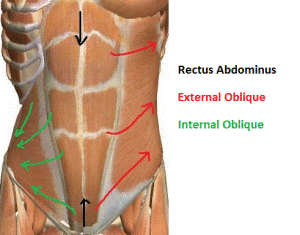Prevent injuries using abdominal bracing
Contents
‘Prevent injuries using abdominal bracing’ is the first article in the ‘Essential Knowledge’ part of this website. This section of the site aims to teach you some simple techniques that are vital if you want to stay healthy, prevent injuries and correct or maintain your posture.
I want to make this clear from the start, when I say essential, I mean essential. The information I am going to share with you in these article is vital. If you don’t learn and practice these techniques then you have no chance of correcting your posture, getting rid of back pain or preventing injury.
In order to prevent injuries and recover from them, you need to learn how your body works and how to maintain your posture. Don’t wait until you are sat in a doctors waiting room in agony. Prevention is always better than cure. Step up and take responsibility for your own posture and health. Your body will thank you for it.
Abdominal bracing and how it helps prevent injuries!
Abdominal bracing is technique that was developed by Dr Stuart McGill (a Professor of spinal biomechanics at the university of Waterloo in Canada). It’s a core stability technique you can use to help maintain the integrity of your spine and prevent injuries.
Your core is simply a term for the muscles that help to protect your spine. For a more thorough explanation of core stability and why I recommend bracing over abdominal hollowing (used in Pilates) please take a took at this article.
Bracing is something that occurs naturally in all healthy active individuals during all movement. It’s an automatic response used by our bodies to help prevent injuries to our spine. The problem is, the majority of us are just not as active as we were created to be. We spend most of our lives sat or laying down. We have therefore, lost our flexibility and this automatic bracing response.
If you watch a toddler reach down to pick up a  heavy toy you will see them execute a perfectly ‘braced’ stable squat. Take a look at them a few years later (when they have started spending a large percentage of their lives sat at their school desks) and you will see a big difference in the way they pick something up.
heavy toy you will see them execute a perfectly ‘braced’ stable squat. Take a look at them a few years later (when they have started spending a large percentage of their lives sat at their school desks) and you will see a big difference in the way they pick something up.
Most of us are unable to avoid sitting for long periods of time. This means we need to reinforce our bodies ability to protect our backs and prevent injuries through practice. We need to re-teach our bodies what they have forgotten!
Now this is the important bit.
Your core should always be on.
The only time these muscles should ever be off is when you are asleep!
Try this experiment on yourself. Stand up and dig the tips of your fingers into the sides of your abs. You should feel a little bit of tension there, if you start to walk you should feel a lot more going on. Try turning on the spot, again you should feel the tension increase slightly.
Now, sit back down again and have another feel of your abs, can you feel how these muscles have turned off? That’s exactly the problem with sitting. When we are sat down our core muscles turn off which compromises our spines and often leads to the development of back pain or other injuries.
Bracing while standing
Stand back up again, making sure that your hips are under your lungs. Now imagine a piece of string has been threaded through your entire upper body. The string goes all the way up from your bum, through every vertebra in your spine to the top of your head. Imagine someone is gently pulling this string upwards, pulling every bone in your back up and making you slightly taller (don’t stick your chest out or lift your chin!).
Take a deep abdominal breath, making sure that your belly inflates as you breathe in. Hold this breath.. now tighten your all of your abs to about 10% of maximum and breathe out whilst keeping this tension. You should find that you can now breathe completely normally with a bit of tension still in your abs. That’s it, that’s how you set your core!
Depending on how aware you are of your own body, you may have noticed that your bum muscle tightened slightly as you engaged your abs. This is because muscles very rarely work alone and often one action triggers another. When you tightened your core your body prepared itself for movement and stabilized your hips at the same time. For a lot of people this bum tightening actually realigns their pelvis into a neutral position. It’s a bit of a 2 for 1.
Bracing while sitting
The technique above can, and should, always be used when sitting. Just sit tall (without sticking your chest out or lifting your chin) take an abdominal breath, tighten up to 10% and breathe out. This should be your default torso position when you are sitting, otherwise you are just hanging off your spine and messing your posture up.
As mentioned in Why sitting is destroying your posture!, most of us sit in a slumped relaxed state, just hanging off our muscles and ligaments. Sitting at 90° angles in a chair isn’t something that our bodies were originally designed to do (chairs haven’t really been around that long).
Sitting is a form of resting and we spend a hell of a lot of time doing it. Therefore it’s not really surprising that our bodies forget how to stabilize our spines and hips. Unfortunately, for most of us sitting is a necessity and part of our working lives. In order to minimize the damage try to keep your core set for as much of the time as you physically can. You may even burn a few extra calories…bonus!
Obviously, keeping your torso braced while sitting for hours on end is pretty challenging. This is why I will be writing another article on different sitting positions soon.
People who struggle with abdominal bracing
As a trainer, I tend to be pretty ‘hands on’ in that I monitor what is happening to my clients bodies as they move. If a muscle isn’t contracting when I know it should be, I prod it with my finger (I do warn them prior to the exercise that they may get a prod :P).
This stimulation enables the client to become aware of their muscles and then start to incorporate them into their movement. Gymnastic coaches often employ a similar technique with their athletes. As do physical therapists with stroke patients.
Learning to brace and set your core without someone there to show you how can be tricky. Therefore I am going to try and give you a few more cues.
Tips on abdominal bracing
- Don’t stick your chest or your bum out when you try to brace.
- Your belly shouldn’t protrude out more when you brace. This is called the ‘valsalva manoeuvre’ and is just you increasing pressure by holding your breath and using creating stiffness using your diaphragm.
- Always remember to take and hold a deep abdominal breath before bracing. Breathe in so that your belly inflates, tighten up then slowly breathe out whilst keeping these muscles tight.
- Don’t pull your belly in. It’s tightening of all of your torso muscles we want, not a TVA contraction.
- Keep your hips under your lungs. Don’t stand there with your pelvis in front of yourself.
- Don’t go nuts unless you are lifting something heavy. Remember we only need about 10% of maximum.
Learn what stiffening a joint feel like.
Put a little bend in your elbow. Now try and tighten the muscles at the front and back of your upper arm at the same time (your biceps and triceps). You need to do this without bending or straightening your elbow. Your elbow should be locked tight so that if someone were to try and move it they would find it difficult. This same principle applies to abdominal bracing. We are pretty much just tensing everything at the same time.
Learn what abdominal bracing feels like.
Stand up and press the tips of all your fingers deep in to your abs, either side of your six pack muscle. As you walk you should be able to some of these muscles tightening slightly. Try and tighten these muscles more as you move just so that you can become more aware of them. Now stop with your feet flat on the floor and try and tighten them at will. Concentrate on how contracting these muscles makes the rest of your body feel. Try to feel the floor under your feet and how tightening these muscles almost feels like a belt wrapping all the way around your torso. Think about your bum, can you feel the muscles their tightening slightly as you brace your core. Practice this again and again while standing until you can do it easily then begin to practice it while sitting.
If you think this article could be useful to someone you know, please help spread the word and share it.

I am reading your article, above, with great interest. I would very much like to improve my posture, core stability, and health overall. However, as I work to do what you suggest I’m having a challenge ensuring that my hips are lined up properly under my lungs as I cannot see my lungs from this angle. Is there another body part I might use to align other than my lungs?
Great article
Your article is so interesting to read. Thanks for sharing these value information.
An MRI shows, a) L3/L4 and L4/L5 discs mild diffuse bulges impinging on thecal sac; L4/L5 disc small postero central broad herniation mildly impinging thecal sac. I have pain radiating through right thigh to foot, and numbness of sole of foot and toes.
What treatment should I undergo ? Wish to avoid surgery
Merely needed to stress Now i’m lucky that i came on your web page!|
I like the idea but agree with the statement above, it is a response to something and not in my opinion the bodies natural way to use the core. Bracing will stiffen the body and yes protect the spine but for normal and functional movements I think bracing will prevent the natural flow of movements needed for sports and everyday tasks even at 10% contraction.
You need to understand the function of this movement, what you should do is practice this for a good few weeks then slowly incorporate the bracing into your physical activities, it does in NO way limit your movement at all, that’s if your doing it properly. Practice, Practice , Practice and you’ll get results, that’s is if you are in some good shape psychically yourself. I use the bracing technique on my athletes and have seen marked improvement in their running gait/movement. But just doing the Abdominal Brace wont give you automatic strong core musculature, you need to be incorporating some type of program where by you include your; Hip Flexor, Hip Stabilizers, Hip Abductors & of course the core musculature.
Good Luck
But doesn’t that limit diaphragm breathing?
during exhale while abdominal bracing are the ribs pulling in(for lack of a better word) since belly is 10% contracted and not being pulled inward
my back hurts frequently, i need to make sure it has good support
after an old injury, my back never got better